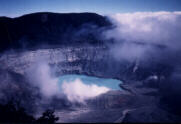
|
On Saturday we taxied to Parque Nacional Póas. A short walk brought us to a lookout
over a spectacular pair of calderas. The summit was ill-defined as we had no good topographic maps
of the park. Nevertheless we all made a "good faith" effort and, in a most ludicrous display
of highpointing madness, ended up spending perhaps 30 minutes trudging, crawling and climbing
some 100 horizontal feet off-trail to what appeared as the local highpoint. The foliage was so thick
that we had to wave at each other from just thirty feet to assess who was the higher!
|